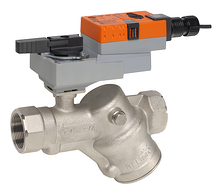Control Valves Meet Challenges of Variable Primary System
Variable primary chilled water systems can be a cost effective alternative to standard primary/secondary systems and are becoming more commonplace for that reason. At the same time, these systems are often more challenging to control. In designing a variable primary system for the new Department of Transportation (DOT) headquarters in Washington D.C., the design firm of DMJM in Arlington, Virginia, met this challenge with pressure independent control valves.
The new DOT building, completed in 2006, sits on an 11-acre site and will have approximately 1.5 million sq. ft. of occupied space. Four chillers, varying in tonnage between 1000 and 2000 tons will serve over 95 air handling units, 90 fan-coil units, several computer room air conditioning units, and over 2000 VAV boxes. While the variable primary system is in keeping with the high efficiency standards of a General Service Administration building, the load and the various chiller sizes complicate control. At the same time, accurate control was a major concern for the DOT, since the facility will include many mission critical spaces.
“With a standard primary/secondary system, it’s easier to know you are getting enough flow through every coil,” said Ali Jannati, Project Engineer for DMJM. “In a variable primary system, you have more components with varying flow values in the mix, so we had to be sure we had very precise control.”
Without pressure independent control, Ali knew that balancing the system at start-up would be extremely difficult and time consuming. One reason is that a building is never completely loaded at start-up, so fluctuations in system pressure unleash numerous balancing issues as a building gradually reaches full occupancy.
The Belimo Pressure Independent Characterized Control Valves (PICCVs), however, arrive at the jobsite factory programmed for a specific operating range, so they require no additional balancing after they are installed - nor do they require re-balancing, as would be the case with a typical control valve/balancing valve configuration.
This results in a large labor savings for the client, says Pete Ewart, Vice President of Business Development for Pritchett Controls, the controls contractor for the DOT project. Not only would the PICCVs provide worry-free control to every coil in the building, the valve/actuator combination would integrate well into the Building Automation System (BAS). For instance, BAS operators can ascertain the position of any valve in the system via the PICCV’s automatic feedback feature, so performance can be monitored 24/7 and problems can be corrected immediately.
How It Works
The PICCV combines a differential pressure regulator with a two-way control valve. It supplies constant flow regardless of pressure variations in the system. The pressure regulator absorbs pressure changes before and after the control surface of the valve, so the differential pressure across the control valve remains constant. This is different from conventional 2-way control valves, whose operation can be severely distorted by system pressure changes.
More accurate flow control means better overall efficiency , and less wear and tear on equipment. Also, if a proportional actuator or three-point actuator with a 2-10 feedback is used, the signal can be used to measure flow. This value can be displayed by a BAS, helping the user see when and where energy is being consumed. “This was a great fit for the DOT project,” remarked the US Government Accounts Manager for Belimo AirControls. “The PICCV is a must-have for complex variable primary systems like this. Accuracy, efficiency , and low maintenance were critical for this large facility.”
The PICCV’s are just one important control feature of the DOT, which happens to be the largest BACnet™ system ever installed by Pritchett Controls. Over 1900 MACH-Air™ native BACnet controls are installed in the building to monitor 90+ air handing units, 1,900+ variable air volume boxes, 90+ fan coil units, and 2 large central plants. In addition, the system integrates packaged pumps, variable frequency drives, chillers, lighting controls, power monitoring and control systems, fire alarms, security, and room reservations.

